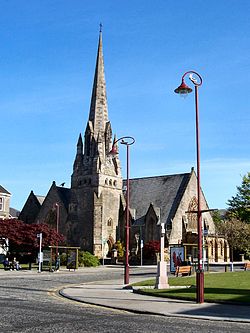Helensburgh
| Helensburgh | |
| Dunbartonshire | |
|---|---|
 Colquhoun Square and the West Kirk | |
| Location | |
| Grid reference: | NS298833 |
| Location: | 56°1’0"N, 4°43’60"W |
| Data | |
| Population: | 14,626 (2001) |
| Post town: | Helensburgh |
| Postcode: | G84 |
| Dialling code: | 01436 |
| Local Government | |
| Council: | Argyll and Bute |
Helensburgh is a well-heeled town and burgh in Dumbartonshire. It lies on the north shore of the Firth of Clyde and the eastern shore of the entrance to the Gareloch.
The town

Helensburgh today acts as a commuter town for nearby Glasgow though in its own right it is a summertime seaside resort. It serves as a main shopping centre for the area. Helensburgh is also influenced by the presence of the Clyde Naval Base at Faslane on the Gare Loch. Helensburgh is also a popular destination for day trippers.
The town is served by three railway stations.
The seafront has an indoor swimming pool, an esplanade walk and sailing facilities including Helensburgh Sailing Club.[1] and the nearby marina at Rhu just beyond the town boundary. The streets are built on a gentle slope rising to the north east, and at the brow of the hill a golf club has views looking south out over the town to the Clyde, and to the north across nearby Loch Lomond to the Trossachs hills.[2]
A regular passenger ferry service runs from Helensburgh pier to Kilcreggan and Gourock. The paddle steamer Waverley calls in to Helensburgh pier during summer sailings.
In a recent study, Helensburgh was shown to be the second most expensive town in which to buy property in Scotland.[3]
The town is used extensively for the local Naval Base, Faslane which is the site that houses the British nuclear deterrent fleet of Vanguard class submarines. The base is only six miles away from the town. A significant amount of income for the town is generated from the base and the submarines based there or visiting.
Helensburgh is home to a number of annual events, with the local branch of Round Table running an annual fireworks display on Guy Fawkes Night and hosting a Real Ale Festival[4] at the Victoria Halls.
History
Helensburgh was founded in 1776 when Sir James Colquhoun of Luss built spa baths on the site of Ardencaple Castle, which dated back to about 1600. He then had the seaside resort town constructed to the east of the spa on a formal layout in the style of Edinburgh's New Town, and named it after his wife Helen. A ferry service he arranged across the Firth of Clyde to Greenock was successful in attracting residents who could commute from jobs there to attractive homes in the new town.[5]
In 1808 Henry Bell bought the public baths and hotel, which his wife superintended while he continued his interest in early steamboats such as the nearby Charlotte Dundas and the North River Steamboat which Robert Fulton had just introduced at New York City. To improve hotel trade he had the paddle steamer [[Comet constructed and in 1812 introduced Europe's first successful steamboat service, bringing passengers down the River Clyde from Glasgow to Greenock and Helensburgh. The Clyde steamer trade developed rapidly, and Helensburgh pier and Craigendoran pier at the east end of the town both became major departure points. From 1858 holidaymakers were brought to the resort and the steamers by the Glasgow, Dumbarton and Helensburgh Railway terminus built in the centre of the town, and in 1894 a second railway station was opened higher up the hill on the West Highland Railway to Fort William.[5]

In 1903, Charles Rennie Mackintosh built the Hill House for the publishing tycoon Walter Blackie. The house, in Colquhoun Street on the north edge of town, is one of the best examples of his style, with startlingly modern interiors incorporating furniture which he designed. It is now owned by the National Trust for Scotland and is a popular tourist attraction.
The baronetcy of Helensburgh
The Raeburn Baronetcy, of Helensburgh in the County of Dunbarton, is a title in the Baronetage of the United Kingdom. It was created on 25 July 1923 for William Raeburn, head of the firm of Raeburn & Verel, Ltd, (a shipping company) and who also represented Dumbartonshire in the House of Commons as a Unionist.